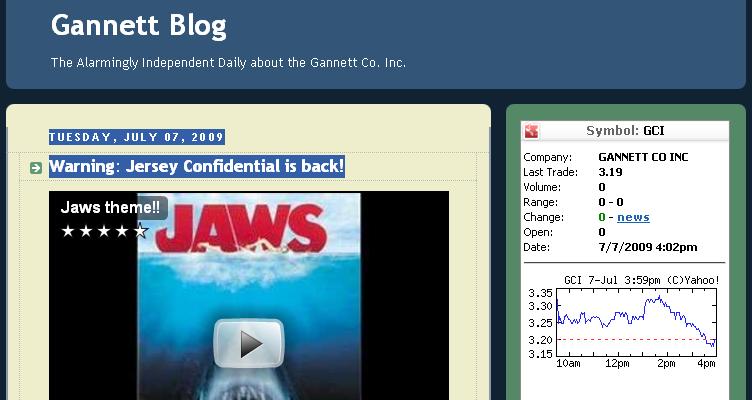
You have to admit, Gannett Blog kind of jumped the shark.
When Jim Hopkins got started with it, Gannett Blog was a useful compendium of news, gossip, tips and analysis about the country’s largest newspaper publishing company, and occasionally he would uncover something nobody else had noticed, like CEO Craig Dubow’s self-serving direction of $40,000 in Gannett Foundation money to an endowed scholarship, in his and his wife’s names, at Western Carolina University.
But lately the site has degenerated into a rather odd mix of self promotion, beefcake, travelogue from Ibiza, more beefcake, and a countdown toward oblivion, which is slated for Friday. Time’s running out! You have just two days left to comment!
Hopkins is redirecting his traffic to Gannettoid, which started up in December. Gannettoid is not a blog; its content lacks clear dates, so it’s not clear that it will be as useful to Gannettoids as Gannett Blog was, at least before it succumbed to self-admiration and hype. Until recently it lacked commenting, as well, but it has recently added a forum for discussion. Maybe it will get around to RSS, also.
Not every major newspaper group is favored with a meta-site where employees and others can get the latest news, leaks, gossip and analysis on their favorite company.
MediaNews groupies can turn to MediaNews Monitor, operated by the Newspaper Guild-CWA, which doesn’t do much reporting of its own, but links to stories and blog posts published elsewhere.
For McClatchyites, CanceltheBee monitors the Sacramento Bee as well as the parent company. It’s run by a laid-off McClatchy staffer, Kevin Gregory, who tends to keep his personality out of it.
But where are the rest of the watchblogs? Among the top groups, Tribune, News Corp., New York Times Company, Hearst, Scripps and CNHI all lack Gannett Blog equivalents, as far as I can tell (but clue me in, if I’m missing something).
Advance/Newhouse and its flagship the Star-Ledger were loosely the focus of The Ledger is Burning, but its proprietor, “sizzlingjboy”, has been AWOL since December (or maybe he got a job). And Lee Watch was keeping an eye on Lee Enterprises until April, but now it also seems to have fizzled.
Newspaper groups would appear to be fertile subjects for independent company-focused blogs. They’re an industry in transition, they are full of writers, they are hotbeds of rumors. On the other hand, the audience for any individual newsco watchblog, even Gannett Blog’s, is relatively small, and shrinking with each wave of layoffs. While some ex-staffers maintain an interest in the doings of their former employers, once you’re terminated, you tend to move on, so the primary audience is those still employed.
And that creates another problem: nearly all commenting at Gannett Blog and the others is anonymous for obvious reasons. That makes a typical comment thread hard to follow. A way to encourage posters to register with pseudonyms might have been useful, but doesn’t cure the credibility issue that comes with anonymous sourcing.
And finally, newspaper journalists are realizing that focusing on the issues of their own company, or even their own industry, is folly — that their personal future lies in the larger, evolving world of information creation and distribution online and across all media. At least, I hope they realize it. The snarkier comments among the “anonymous” crowd sometimes betray states of denial and unrealistic feelings of entitlement, rather than any interest in the future of journalism.
In any event, with or without a company watchblog, journalists and others in the business have other, generally better avenues for monitoring the pulse of their employer and the industry: Paul Gillin’s Newspaper Death Watch monitors both the decline and fall of legacy enterprises and the emergence of new models in admirable detail; the indefatigable Jim Romenesko’s aggregation of daily news blurbs at Poynter is required reading; and of course, you can find us pontificating daily here at NiemanLab.